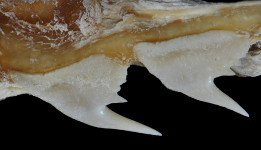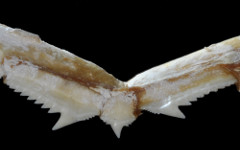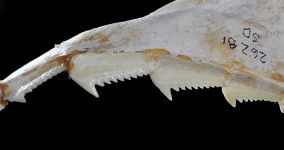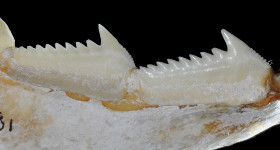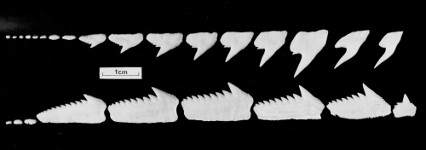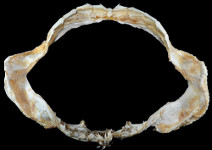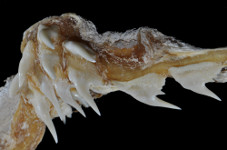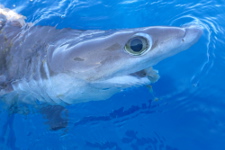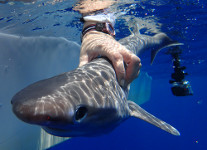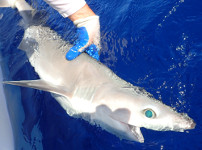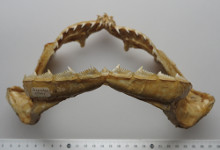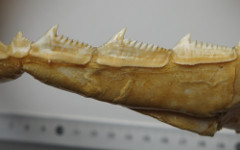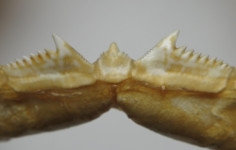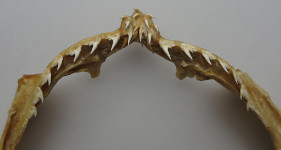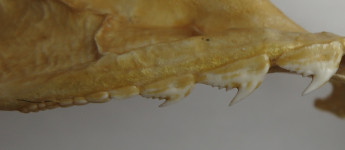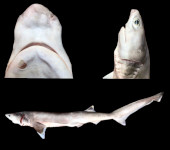Hexanchus vitulus
Springer & Waller, 1969
Bigeye sixgill shark
Classification: Elasmobranchii Hexanchiformes Hexanchidae
Reference of the original description
Hexanchus vitulus, a New Sixgill Shark from the Bahamas. Bulletin of Marine Science, 19(1), 159–174
Hexanchus vitulus, a New Sixgill Shark from the Bahamas. Bulletin of Marine Science, 19(1), 159–174
Image of the original description
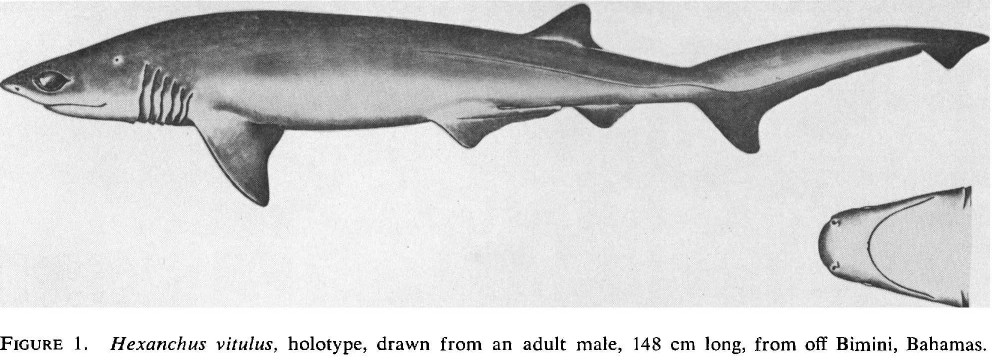
Hexanchus vitulus Springer & Waller, 1969; holotype, adult male, 148 cm TL, Bimini Bahamas, in: Springer, S. & WALLER, R.A. 1969 Hexanchus vitulus, a New Sixgill Shark from the Bahamas. Bulletin of Marine Science, 19 (1): 159–174

Hexanchus vitulus Springer & Waller, 1969; holotype, adult male, 148 cm TL, Bimini Bahamas, in: Springer, S. & WALLER, R.A. 1969 Hexanchus vitulus, a New Sixgill Shark from the Bahamas. Bulletin of Marine Science, 19 (1): 159–174
Description :
Citation: Hexanchus vitulus Springer & Waller, 1969: In: Database of modern sharks, rays and chimaeras, www.shark-references.com, World Wide Web electronic publication, Version 01/2026
Please send your images of "Hexanchus vitulus" to info@shark-references.com

Hexanchus vitulus Springer & Waller, 1969; 25.2.2017 © Thomas Meyer

Hexanchus vitulus Springer & Waller, 1969; 25.2.2017 © Thomas Meyer
Common names
Atlantic sixgill shark
Atlantic sixgill shark
Short Description
Original diagnosis of SPRINGER & WALLER, 1969 [2272]: Hexanchus vitulus is a small species that becomes sexually mature at a length of 140 to 175 em and probably reaches lengths not much greater than 180 cm. In contrast, H. griseus is reported to reach lengths greater than 450 cm. H. vitulus has only five rows of large trapezoidal teeth on each side in the lower jaw, whereas H. griseus has six rows. We have found no exceptions in the material we have examined. H. vitulus differs from H. griseus in body proportions, but because of allometry it is difficult to use proportional measurements for the identification of single specimens. In all of the material we have examined, however, H. vitulus has a proportionally larger eye and longer snout (measured from the front of the mouth) than H. griseus. Also, a proportionally greater distance separates the bases of the dorsal fin and anal fin from the origin of the caudal fin than in H. griseus. Shapes of fins may also prove to be useful diagnostic characters, at least in comparison of young specimens. In H. vitulus the distal margin of the pectoral fin is somewhat concave both in adults and in the young. Young H. vitulus have a slightly more definite lower caudal lobe than young H. griseus. We are uncertain about details of fin shape in large H. griseus, since our data on specimens are from photographs and from incomplete field notes and measurements. The upper margin of the distal half to nine-tenths of the caudal fin carries a series of enlarged denticles in all examples of Hexanchus that we have seen, but the prominence of these denticles and their size relative to the size of denticles on the sides of the caudal fin are reduced in large specimens. Adults of H. vitulus and also large specimens of H. griseus have the enlarged denticles only on the distal half of the caudal fin. In H. vitulus, however, the lateral surface of the upper distal portion of the caudal fin of the adults is covered by imbricate denticles of nearly uniform size, whereas in the single large example of H. griseus (a 433-cm female) that we have examined in detail, denticles of that area were of various sizes, irregularly distributed, and not imbricate.
Original diagnosis of SPRINGER & WALLER, 1969 [2272]: Hexanchus vitulus is a small species that becomes sexually mature at a length of 140 to 175 em and probably reaches lengths not much greater than 180 cm. In contrast, H. griseus is reported to reach lengths greater than 450 cm. H. vitulus has only five rows of large trapezoidal teeth on each side in the lower jaw, whereas H. griseus has six rows. We have found no exceptions in the material we have examined. H. vitulus differs from H. griseus in body proportions, but because of allometry it is difficult to use proportional measurements for the identification of single specimens. In all of the material we have examined, however, H. vitulus has a proportionally larger eye and longer snout (measured from the front of the mouth) than H. griseus. Also, a proportionally greater distance separates the bases of the dorsal fin and anal fin from the origin of the caudal fin than in H. griseus. Shapes of fins may also prove to be useful diagnostic characters, at least in comparison of young specimens. In H. vitulus the distal margin of the pectoral fin is somewhat concave both in adults and in the young. Young H. vitulus have a slightly more definite lower caudal lobe than young H. griseus. We are uncertain about details of fin shape in large H. griseus, since our data on specimens are from photographs and from incomplete field notes and measurements. The upper margin of the distal half to nine-tenths of the caudal fin carries a series of enlarged denticles in all examples of Hexanchus that we have seen, but the prominence of these denticles and their size relative to the size of denticles on the sides of the caudal fin are reduced in large specimens. Adults of H. vitulus and also large specimens of H. griseus have the enlarged denticles only on the distal half of the caudal fin. In H. vitulus, however, the lateral surface of the upper distal portion of the caudal fin of the adults is covered by imbricate denticles of nearly uniform size, whereas in the single large example of H. griseus (a 433-cm female) that we have examined in detail, denticles of that area were of various sizes, irregularly distributed, and not imbricate.
Distribution
Records for H. vitulus exist in the northwest Atlantic from the northern Bahamas throughout the Gulf of Mexico (U.S., Mexico and Cuba) through Central America at least to Costa Rica [26082]
Records for H. vitulus exist in the northwest Atlantic from the northern Bahamas throughout the Gulf of Mexico (U.S., Mexico and Cuba) through Central America at least to Costa Rica [26082]
Biology
Ovoviviparous
Ovoviviparous
Remarks
shark-references Species-ID=2872;
shark-references Species-ID=2872;








